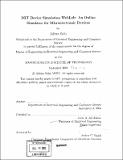MIT Device Simulation WebLab : an online simulator for microelectronic devices
Author(s)
Solis, Adrian (Adrian Orbita)
DownloadFull printable version (9.113Mb)
Alternative title
WeblabSim
Other Contributors
Massachusetts Institute of Technology. Dept. of Electrical Engineering and Computer Science.
Advisor
Jesús A. del Alamo.
Terms of use
Metadata
Show full item recordAbstract
In the field of microelectronics, a device simulator is an important engineering tool with tremendous educational value. With a device simulator, a student can examine the characteristics of a microelectronic device described by a particular model. This makes it easier to develop an intuition for the general behavior of that device and examine the impact of particular device parameters on device characteristics. In this thesis, we designed and implemented the MIT Device Simulation WebLab ("WeblabSim"), an online simulator for exploring the behavior of microelectronic devices. WeblabSim makes a device simulator readily available to users on the web anywhere, and at any time. Through a Java applet interface, a user connected to the Internet specifies and submits a simulation to the system. A program performs the simulation on a computer that can be located anywhere else on the Internet. The results are then sent back to the user's applet for graphing and further analysis. The WeblabSim system uses a three-tier design based on the iLab Batched Experiment Architecture. It consists of a client applet that lets users configure simulations, a laboratory server that runs them, and a generic service broker that mediates between the two through SOAP-based web services. We have implemented a graphical client applet, based on the client used by the MIT Microelectronics WebLab. (cont.) Our laboratory server has a distributed, modular design consisting of a data store, several worker servers that run simulations, and a master server that acts as a coordinator. On this system, we have successfully deployed WinSpice, a circuit simulator based on Berkeley Spice3F4. Our initial experiences with WeblabSim indicate that it is feature-complete, reliable and efficient. We are satisfied that it is ready for beta deployment in a classroom setting, which we hope to do in Fall 2004.
Description
Thesis (M. Eng.)--Massachusetts Institute of Technology, Dept. of Electrical Engineering and Computer Science, June 2005. Includes bibliographical references (p. 149-157).
Date issued
2005Department
Massachusetts Institute of Technology. Department of Electrical Engineering and Computer SciencePublisher
Massachusetts Institute of Technology
Keywords
Electrical Engineering and Computer Science.